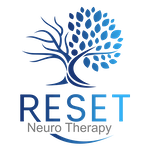RESET - Booklet - Manual / Resource - Page 12

RESET your brain.
RESET your life.
How Ketamine Therapy Resets Your Brain
Unlike traditional antidepressants, ketamine therapy can actually repair damaged neural pathways
rather than dulling the signals.
When people experience depression, anxiety, pain, and other forms of stress, the brain’s communication system for memory, learning, and higher-order thinking can be damaged. Ketamine is
thought to repair this damage on several levels.
Ketamine acts as an N-Methyl D-Aspartate (NMDA) receptor antagonist, meaning that it inhibits
the transfer of electric signals between neurons in the brain and the spinal column. This is why ketamine has traditionally been used as a very safe and effective anesthetic in medical and surgical
situations for children, adults, and animals for more than 50 years. Because of this effect, ketamine can help train chronic pain without the addictive qualities of opioids.
Ketamine also acts as a glutamate receptor antagonist. Glutamate regulates large regions of the
nervous system and is the most prominent neurotransmitter in the brain. When glutamate receptors are over-activated, a person may experience long-term depression. Ketamine works by blocking these glutamine receptors.
Studies have also shown that ketamine enhances the brain’s structural plasticity, or its ability to
change its physical structure as a result of learning. If the mind is injured or damaged by disease
or stress, neuroplasticity allows it to reset and recover by reorganizing its physical structure.